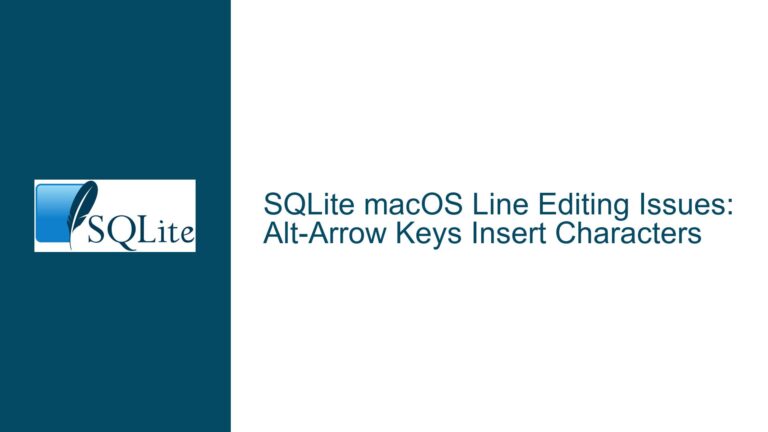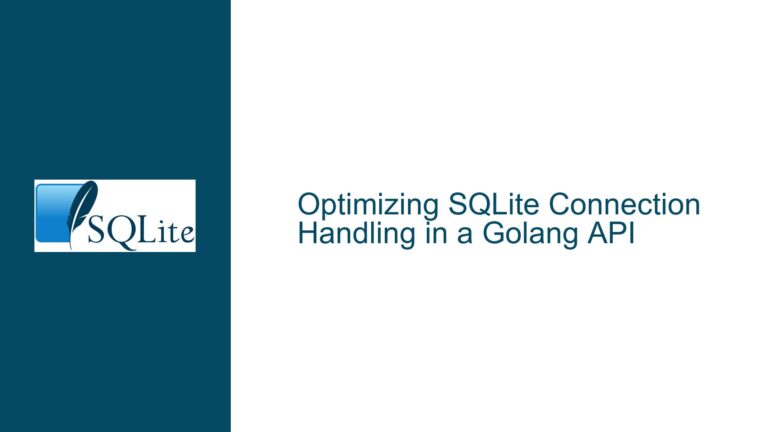Resolving SQLite TCL API Access and Dynamic Query Building Issues
SQLite TCL API Function Access and Dynamic Query Challenges
When working with SQLite in a TCL environment, one of the most common issues developers face is the inability to access certain API functions, such as sqlite3_prepare, which are crucial for building dynamic SQL queries. This problem often manifests when developers attempt to use these functions to prepare statements dynamically, only to find that the functions are either unavailable or not behaving as expected. The core of the issue lies in the misunderstanding or misconfiguration of the SQLite TCL bindings, which can lead to frustration and wasted time.
The sqlite3_prepare function is a fundamental part of the SQLite C API, used to compile SQL statements into bytecode that can be executed by the SQLite virtual machine. In TCL, this function is typically accessed through the TCL SQLite binding, which provides a bridge between TCL scripts and the SQLite C library. However, if the binding is not correctly set up or if there are discrepancies in the environment, the function may not be accessible, leading to the symptoms described.
The inability to access sqlite3_prepare directly in TCL can severely hinder the development of dynamic query builders, which rely on the ability to construct and execute SQL statements on the fly. This is particularly problematic in scenarios where the structure of the database or the nature of the queries is not known in advance, requiring a flexible approach to SQL statement construction.
Misconfigured TCL Bindings and Missing API Functions
The primary cause of the issue is often a misconfiguration or incomplete installation of the SQLite TCL bindings. The TCL SQLite binding, which is provided by the tclsqlite library, must be correctly installed and linked to the SQLite C library for the API functions to be accessible. If the binding is not properly set up, certain functions, including sqlite3_prepare, may not be exposed to the TCL environment.
Another potential cause is the use of an outdated or incompatible version of the TCL SQLite binding. SQLite is continuously updated, and new versions may introduce changes to the API or the way functions are exposed to bindings. If the TCL binding being used is not compatible with the version of SQLite installed on the system, certain functions may not be available or may behave unexpectedly.
Additionally, the issue could stem from a misunderstanding of how the TCL SQLite binding works. The binding provides a high-level interface to SQLite, abstracting many of the low-level details of the C API. This abstraction can sometimes obscure the availability of certain functions, leading developers to believe that functions like sqlite3_prepare are not available when they actually are, but accessed differently.
Correcting TCL Binding Configuration and Utilizing SQLite API Functions
To resolve the issue, the first step is to ensure that the TCL SQLite binding is correctly installed and configured. This involves verifying that the tclsqlite library is present in the TCL environment and that it is correctly linked to the SQLite C library. On most systems, this can be done by checking the TCL package path and ensuring that the tclsqlite package is available. If the package is missing, it can be installed using the system’s package manager or by compiling it from source.
Once the binding is confirmed to be correctly installed, the next step is to verify that the sqlite3_prepare function is accessible. This can be done by attempting to load the tclsqlite package and checking for the presence of the function using the info command TCL command. If the function is not found, it may be necessary to recompile the binding or update to a newer version that is compatible with the installed version of SQLite.
If the function is accessible but not behaving as expected, it may be necessary to review the documentation for the TCL SQLite binding to understand how the function is intended to be used. The binding may provide a different interface for preparing statements, such as a prepare method on the database object, which should be used instead of directly calling sqlite3_prepare.
For developers who need to build dynamic SQL queries, it is important to understand the capabilities and limitations of the TCL SQLite binding. While the binding may not provide direct access to all of the low-level functions of the SQLite C API, it typically offers a sufficient set of tools for constructing and executing SQL statements dynamically. This may involve using TCL’s string manipulation capabilities to build SQL statements as strings and then executing them using the binding’s eval or execute methods.
In cases where the TCL SQLite binding does not meet the needs of the application, alternative approaches may be considered. One such approach is to use a different database system that provides a more suitable TCL binding, such as PostgreSQL with the tclodbc package. Another option is to use the SWIG tool to generate a custom TCL binding for SQLite, although this approach is generally more complex and time-consuming.
In conclusion, the issue of accessing SQLite API functions in a TCL environment is typically rooted in misconfiguration or misunderstanding of the TCL SQLite binding. By ensuring that the binding is correctly installed and configured, and by familiarizing oneself with the binding’s interface and capabilities, developers can overcome these challenges and successfully build dynamic SQL queries in TCL. For those who require additional flexibility or functionality, alternative database systems or custom bindings may provide a viable solution.






